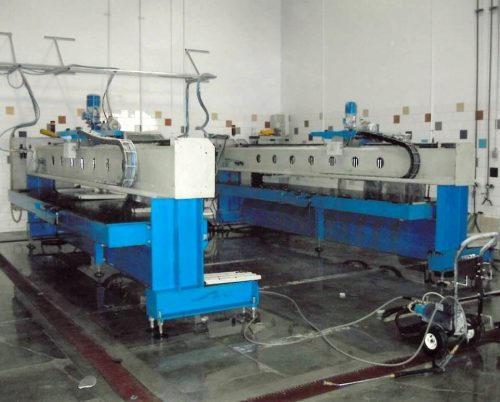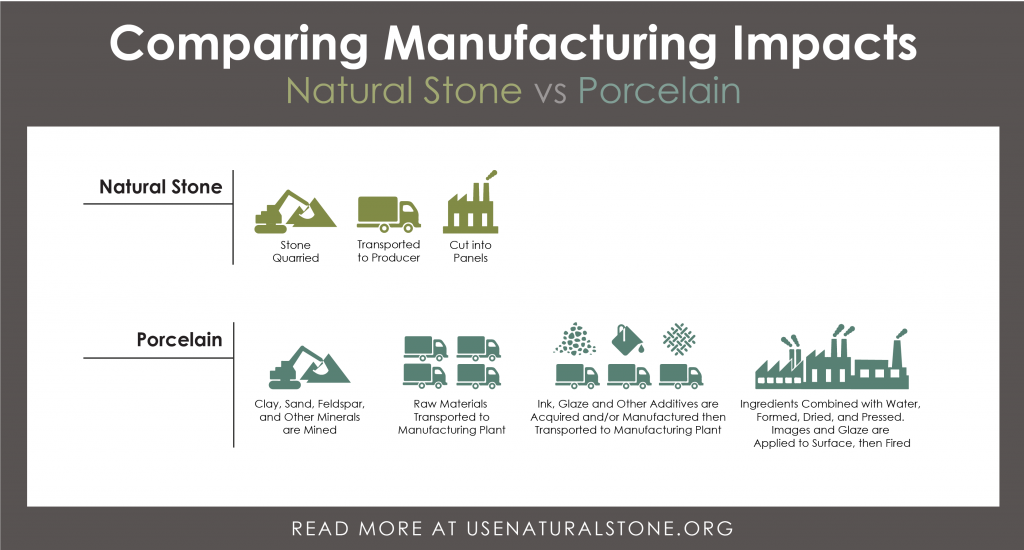Sintered surface, also known as ultra-compact surface, is an engineered product that is dense, durable, and resistant to stains, heat, and scratches. The material can be used in many different applications including interior kitchens and bathrooms, and exterior applications such as wall cladding and countertops. This is due to the material’s various thicknesses and durability, and because it has a low porosity and does not fade from UV exposure. The intended design gets printed on the surface but typically does not go all the way through the material. This means that the ends and edges may not have the same color or pattern as the rest of the surface. Sintered surface has an increased risk of chipping due to its denseness and hardness. The edges are especially prone to damage if impacted and can be difficult to repair.
Sintered surface is sometimes marketed as sustainable because it contains natural materials. But as you will see from the manufacturing process described below, the use of an energy intensive manufacturing process gives sintered surface a larger environmental footprint than natural stone.

A sintered stone slab with an interesting texture ready for use as a countertop. Photo Credit: Wikimedia Commons/JonSmith37341.
Manufacturing Sintered Surface vs. Natural Stone
Sintered surfaces are created with several natural materials including kaolin, feldspars, silico-aluminates, and clays, which are first mined out of the ground. The raw materials are then transported to a manufacturing plant, where they must then undergo a complex, energy intensive process that simulates, or mimics, hundreds of years of metamorphic change. To manufacture a sintered surface requires several different stages of processing including grinding, mixing, reacting, stabilizing, separating, and drying. This resulting mixture is then subjected to immense pressure and extreme heat—more than 2,000o F—to fuse the materials together, all of which requires a lot of energy.
In contrast, natural stone requires only quarrying, fabricating, finishing, and transporting. No additive materials or chemicals are required to create natural stone. Stone is formed naturally by the Earth over time. Several types of natural stone, including marble and gneiss, undergo metamorphoses within the Earth’s crust where extreme pressure and heat transform the deposit from a more porous material to a harder and denser material. This process happens over millions of years in the ground. This means natural stone really is a natural material and has many other attributes, including its durability, recyclability, and wide range of aesthetics. Natural stone can be used in many different indoor and outdoor applications as well and contains no Volatile Organic Compounds (VOCs), meaning it does not emit any harmful gases, making it a healthy material. 
Sustainability Concerns
From an overall sustainability perspective, natural stone has a lower environmental footprint than a sintered surface. This is due to the minimal resources used to quarry, fabricate, finish, and transport natural stone. Each step in the sintered surface manufacturing process requires the use of energy, which contributes to the total GWP. The larger the GWP, the more that a given gas warms the Earth compared to carbon dioxide (CO2) over the same timeframe.
These characteristics and attributes also make natural stone a great choice when seeking a green building rating certification within the U.S. Green Building Council’s Leadership in Energy and Environmental Design (LEED) or the International Living Future Institute’s Living Building Challenge (LBC). The different manufacturing processes and impacts of building materials are being documented in product labels such as Environmental Product Declarations (EPDs) and Health Product Declarations (HPDs). These labels make it even easier to qualify for points and credits within LEED and other green building rating systems using natural stone. The labels document and quantify environmental information on the life cycle of a product and allow you to make comparisons and informed decisions on materials that fulfill the same function. The product labels are also intended to demonstrate that the health and environmental claims are transparent, accurate, and meet defined standards. Industry-wide EPDs are available for natural stone cladding, flooring/paving, and countertops. HPDs are available for common natural stone types used in the dimension stone industry including granite, limestone, marble, quartzite, onyx, sandstone, slate, travertine, and more. (See also: Environmental and Health Product Labels for Natural Stone.)
To further advance these issues, the natural stone industry has been working diligently over the years to make continuous improvements in each area and step of the process. This includes reducing water use, energy use, improving the efficiency of the transportation of natural stone, properly managing and adaptively reusing quarry sites, and many others.

An example of a stone fabrication plant recycling and reusing water in the polishing stage, saving thousands of gallons of water annually. Photo Credit: Dennett Tile & Stone
The natural stone industry has created a certification system that determines if a quarry or fabricator meets defined sustainability standards in key areas of importance. This makes it easier to find and use natural stones that meet the standard, simplifying the process of choosing the right material that not only looks and performs well, but also has the least amount of impact on the environment. The standard is also accepted within the LBC, further ensuring its use in sustainable building projects. The metrics of the Natural Stone Sustainability Standard can be used to vet stone suppliers even if they have not yet achieved certification. More information is available via the Natural Stone Institute or NSF International.






